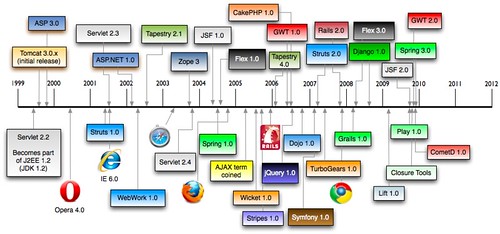My Future of Web Frameworks Presentation
Earlier this week, I tweeted about a history of web frameworks timeline I created for my upcoming Future of Web Frameworks talk at TSSJS Vegas 2010. I immediately received a lot of feedback and requests for adding new frameworks and releases. The image below is the result of that Twitter conversation. Thanks to everyone who contributed.
Back in November, I wrote about my proposals for TSSJS. I've been thinking a lot about web frameworks lately and I can't help but think we live in a very exciting time. As a Java developer, I've been exposed to one of the most vibrant language ecosystems on the planet. As Tim Bray talks about, the Java Platform has 3 legs: the language, the virtual machine and a huge, immense library of APIs (both in the JDK and in open source libraries). The diagram below is something I created based on Tim's podcast.
Tim says, "One of those legs is replaceable and that's the language." And he's right, there's many Java.next languages that run efficiently on the JVM. This is one of the most exciting parts of being a Java web developer today. There's many proven web frameworks and languages that you can pick to build your next web application.
The best part is many of the best web frameworks run on the JVM. Not only that, but the best code editors are the IDEs that you're familiar with and have grown to love. Furthermore, much of the literature for Java.next languages is written for Java developers. As someone who knows Java, you have wealth of web frameworks and languages just waiting for you to learn them.
To create my presentation on the future of web frameworks, I followed the outline I posted previously. I plan on explaining the evolution and history of web frameworks and how we got to where we are today. From there, I'll be speculating on what web applications we'll be developing in the future. Finally, I'll touch on the necessary features of web frameworks that will allow us to develop these applications.
Of course, I haven't actually presented this talk yet, so it's likely to change in the coming weeks before the conference. The good news is this gives you the opportunity to provide constructive criticism on this presentation and help make it better. I realize that a presentation rarely represents the conversation that takes place during a conference. However, I believe it can portray the jist of my thinking and lead to a meaningful conversation in the comments of this post. Below is the presentation I created - thanks in advance for any feedback.
For those who will be joining me at TSSJS ... it's gonna be a great show. St. Patrick's Day in Vegas, what more could you ask for? 
Update: This article has been re-posted on Javalobby and contains additional community feedback in the comments.




Nice presentation. I hope, after your present it, you post it again with audio.
I absolutely agree with you, site speed is taking predominance now, as more of broadband users are increasing. And SOA matters. Build services, use UI layer as switchable face place for API or services.
Or I would go over single component with different UIs. One for browsers, one for mobile users.
Posted by ashish on February 26, 2010 at 04:59 PM MST #
Posted by uberVU - social comments on February 26, 2010 at 06:46 PM MST #
Speaking of future, Servlet 3.0 (released as part of Java EE 6 in December 09) was built with extensibility in mind. While most developers are not expected to use it directly, it'd expect it to play a role in the future of Java frameworks. Oh, and it has an async API (while we all wait for websockets).
JSF 2.0 was released late 2009, not 2008 (if I read the timeline correctly)
Posted by Alexis MP on February 28, 2010 at 04:26 PM MST #
Posted by André Faria Gomes on March 01, 2010 at 01:10 AM MST #
Posted by Matt Raible on April 13, 2010 at 09:14 PM MDT #